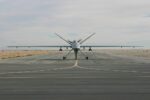The United States and Taiwan have jointly launched a new unmanned combat aerial vehicle (UCAV) initiative by repurposing the BQM-167A Firejet target drone into a high-speed strike platform dubbed the “Mighty Hornet IV.” The project is spearheaded by Taiwan’s National Chung-Shan Institute of Science and Technology (NCSIST) in collaboration with U.S. defense industry partners. The effort reflects a growing trend in leveraging existing airframes for rapid UCAV development amid rising tensions across the Taiwan Strait.
From Target Drone to Combat-Capable UCAV
The BQM-167A Firejet was originally developed by Kratos Defense & Security Solutions as a subsonic aerial target for training and weapons testing. With a top speed of Mach 0.91 and an operational ceiling of 15,000 meters, it simulates enemy aircraft for live-fire exercises. However, its robust airframe and modular avionics have made it an attractive candidate for conversion into an expendable or semi-expendable combat drone.
The Mighty Hornet IV builds upon this foundation with significant upgrades:
- Combat payload integration: Modified internal bays or underwing hardpoints to carry precision-guided munitions or electronic warfare (EW) pods.
- AI-enabled autonomy: Onboard mission computers capable of autonomous navigation, target recognition, and swarm coordination.
- C4ISR connectivity: Enhanced datalinks compatible with Taiwanese and U.S. command-and-control networks.
NCSIST has reportedly led the software integration effort while leveraging U.S.-supplied hardware under Foreign Military Sales (FMS) frameworks. The design is optimized for mass production using composite materials and commercial off-the-shelf (COTS) components to keep unit costs low—estimated at under $1 million per airframe.
Tactical Role: Loyal Wingman or Decoy?
The Mighty Hornet IV is designed to fulfill multiple tactical roles depending on mission configuration:
- Loyal wingman: Escorting manned fighters like Taiwan’s F-16V or Indigenous Defense Fighter (IDF), providing sensor extension and distributed lethality.
- Strike platform: Delivering stand-off munitions against radar sites or amphibious landing forces in contested environments.
- Decoy/penetrator: Drawing enemy surface-to-air missile (SAM) fire to expose air defense positions for follow-on strikes.
This flexibility aligns with emerging concepts of operations (CONOPS) such as Distributed Air Operations and Mosaic Warfare advocated by both U.S. Indo-Pacific Command and Taiwan’s military planners. The platform’s expendability also allows it to be used aggressively without risking high-value assets.
Strategic Context: Deterrence Through Quantity
Taiwan faces a significant numerical disadvantage against China’s People’s Liberation Army Air Force (PLAAF), which fields over 1,500 combat aircraft compared to Taiwan’s ~300 operational fighters. To offset this asymmetry, Taipei has prioritized asymmetric capabilities including mobile SAMs, anti-ship missiles—and now unmanned systems like the Mighty Hornet IV.
The program reflects lessons from Ukraine’s use of low-cost drones such as FPVs and converted reconnaissance UAVs in attritional warfare against Russian forces. By fielding swarms of fast-moving UCAVs that can overwhelm defenses or saturate ISR networks, Taiwan aims to complicate PLA planning during any potential invasion scenario.
Industrial Collaboration Between NCSIST and U.S. Partners
NCSIST serves as Taiwan’s premier defense R&D institute responsible for indigenous missile systems like Tien Kung SAMs and Hsiung Feng anti-ship missiles. For the Mighty Hornet IV project, NCSIST reportedly collaborates directly with Kratos Defense—the original manufacturer of the Firejet—as well as other unnamed U.S.-based avionics suppliers under ITAR-compliant arrangements.
This cooperation mirrors broader trends in U.S.-Taiwan defense industrial ties post-2020s arms sales packages that included MQ-9B SeaGuardian drones and HIMARS rocket artillery systems. While Washington maintains strategic ambiguity on direct military intervention in case of conflict over Taiwan, technology transfer programs like these signal increasing interoperability between both militaries.
Testing Timeline and Operational Outlook
The first flight tests of the Mighty Hornet IV prototype reportedly occurred at Jiupeng missile test range in southern Taiwan during Q3 2025 under restricted airspace conditions. According to local defense sources cited by Liberty Times Net (LTN), test goals included validating autonomous flight control algorithms, datalink stability under jamming conditions, and simulated strike profiles against mock targets inland.
If testing continues successfully through early 2026, initial low-rate production could begin by mid-year with deployment to select ROCAF squadrons near key coastal installations such as Tainan AB or Hualien AB—both within range of potential PLA amphibious thrust axes across the strait.
Challenges Ahead: Survivability vs Cost Tradeoffs
A key challenge will be balancing cost-effectiveness with survivability in high-threat environments dominated by PLA integrated air defenses including HQ-9B SAMs and J-20 stealth interceptors equipped with AESA radars. While expendability is part of the design philosophy, achieving sufficient EW shielding or radar cross-section reduction may require further iteration—possibly through stealth coatings or signature management techniques borrowed from LOCAAS-type programs.
An additional concern involves C4ISR resilience under cyber/electronic attack—a domain where China has demonstrated growing capability via GNSS spoofing and long-range jamming platforms like KJ-500 AEW&C aircraft equipped with ECM suites targeting UAV control links at scale.
A Glimpse Into Future Force Structure
If successful at scale-up production levels (~100–200 units annually), Mighty Hornet IV could become a core component of Taiwan’s future unmanned strike force alongside larger MALE-class drones like Teng Yun II or imported MQ-9Bs. This layered approach would allow graduated response options—from ISR-only missions up through kinetic saturation attacks—without committing manned assets prematurely in crisis scenarios.









